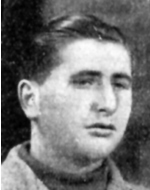Yehezkel, the son of Rachel and Abraham, was born in 1925 in the city of Slatoniska-Dolly in Czechoslovakia, and at a very young age began to study Torah in the cheder and excelled in his studies. Czechoslovakia was created at the end of the First World War, after the dissolution of the Austro-Hungarian Empire, and included the most industrialized areas of the Kingdom, and after the signing of the Munich Agreement in September 1938, Czechoslovakia was granted independence and became a German protectorate, and in March 1939 the Nazi army invaded Czechoslovakia and Hitler He declared Protectorate in the areas inhabited by a German minority: Bohemia and Moravia, the Hungarian army invaded the southern part of the country, and more than 300,000 Jews lived in Czechoslovakia on the eve of World War II.In September 1939, The Jews in all regions began their reign of terror, their freedom of movement was limited, they were fired from their jobs, food rationed, the Jews annexed to Hungary were granted relative freedom until 1944, when the Germans conquered the country and were sent to ghettos and extermination camps. By the end of the war about two-thirds of the Jews of Czechoslovakia had been exterminated. In 1944, Yehezkel and his parents were taken to the death camp in Auschwitz. The parents perished, and only Yehezkel managed to hold out until the end of the war. At the end of the war he met with his cousin in Italy, who gave him the right to immigrate to Israel. On December 14, 1945, Yehezkel boarded the illegal immigrant ship Hannah Szenes. The ship, which was purchased in Italy by the Haganah’s Mossad Le’Aliyah Bet, sailed from the port of Savannah, Italy, carrying 252 immigrants, mostly members of Zionist youth movements. The conditions of the voyage were harsh: the overcrowding was high, the air was crowded, and the food and water were not enough. The sea stormed and the number of patients grew during the voyage. Ten days after leaving, the ship boarded a beach in Nahariya. Members of the Palyam coastal group (Palmach naval company), with the assistance of residents from Nahariya and the surrounding area, helped to transfer the immigrants to the shore by means of ropes. They were then transported by bus and truck to the surrounding kibbutzim, from which they were dispersed throughout the country. At the Nahariya beach, a banner was left on the Nahariya beach: “The name of the ship Hannah Senesh was taken down with the help of the Hebrew Haganah, and this ship will be one of the gravestones for six million of our brothers and sisters.” Upon his arrival in Israel, Yehezkel joined the religious Kibbutz Tekuma in the Negev. He stayed there for a short time, then moved to Hadera and began working in the bakery. At the outbreak of the War of Independence, Yehezkel was among the first volunteers. With the reorganization of the Israel Defense Forces, a full mobilization was enlisted and attached to the Alexandroni Brigade, which is the No. 3 Brigade. Since then, the brigade has held various positions, mainly in the battles in central Israel. On August 19, 1948, when he was in a military camp near the coast in Netanya, Yechezkel went to bathe in the sea, drowned and died. Twenty-three years old when he died. Yehezkel was laid to rest in the military cemetery in Netanya. This hero is a “last scion”. The survivors of the Holocaust are survivors of the Holocaust who survived the last remnant of their nuclear family (parents, brothers, sisters, sons and daughters) who experienced the Holocaust in the ghettos and / or concentration camps and / or in hiding and hiding in territories occupied by the Nazis and / Or in combat alongside members of the underground movements or partisans in the Nazi-occupied territories who immigrated to Israel during or after World War II, wore uniforms and fell in the Israeli army.
